Delicately flavored with a light, creamy texture, these Roasted Cauliflower Souffles with goat cheese, roasted garlic, and chives are a beautiful dish for a vegetarian lunch or brunch.
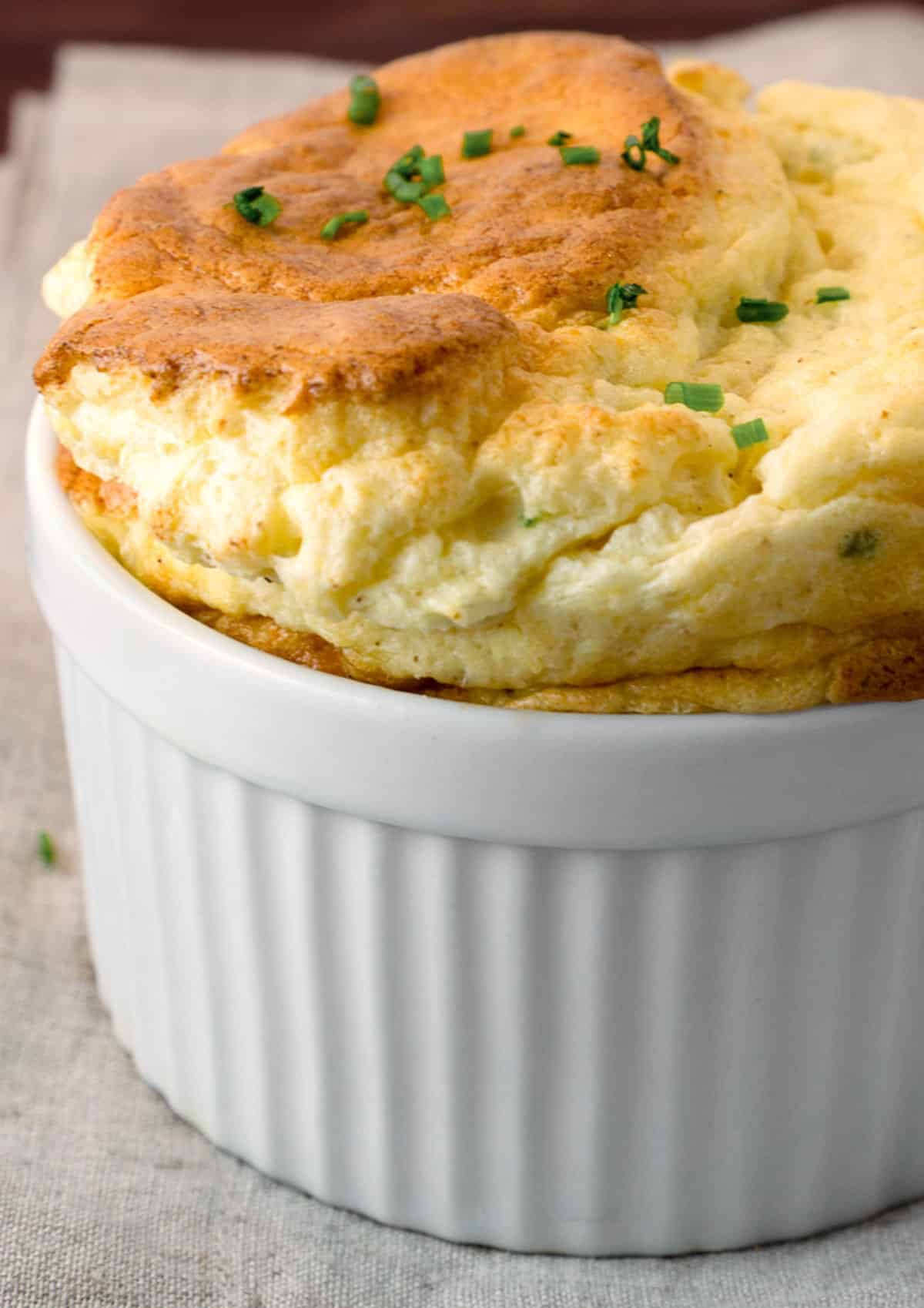
Why You’ll Love These Souffles
- Perfect for Brunch: This Roasted Cauliflower and Goat Cheese Soufflé recipe is a brunch showstopper. It offers a sophisticated twist on traditional brunch fare, highlighting flavors that are perfect for spring.
- Beautiful Marriage of Flavors: These souffles are balanced with caramelized roasted cauliflower, sweet roasted garlic, tangy goat cheese, and fresh chives. The cauliflower flavor isn’t overly assertive in this recipe; in fact, these soufflés are as delicately flavored as they are textured.
- Impressive: A pillowy, tall soufflé is a statement piece on the table. Though this recipe takes some time and has a number of steps, I’ve broken them down into manageable parts so that you can be confident that you’ll wow your guests, even if this is your first time making a soufflé!
Love roasted cauliflower? You might also enjoy my Curried Cauliflower Soup. It’s creamy, cozy, and satisfying.
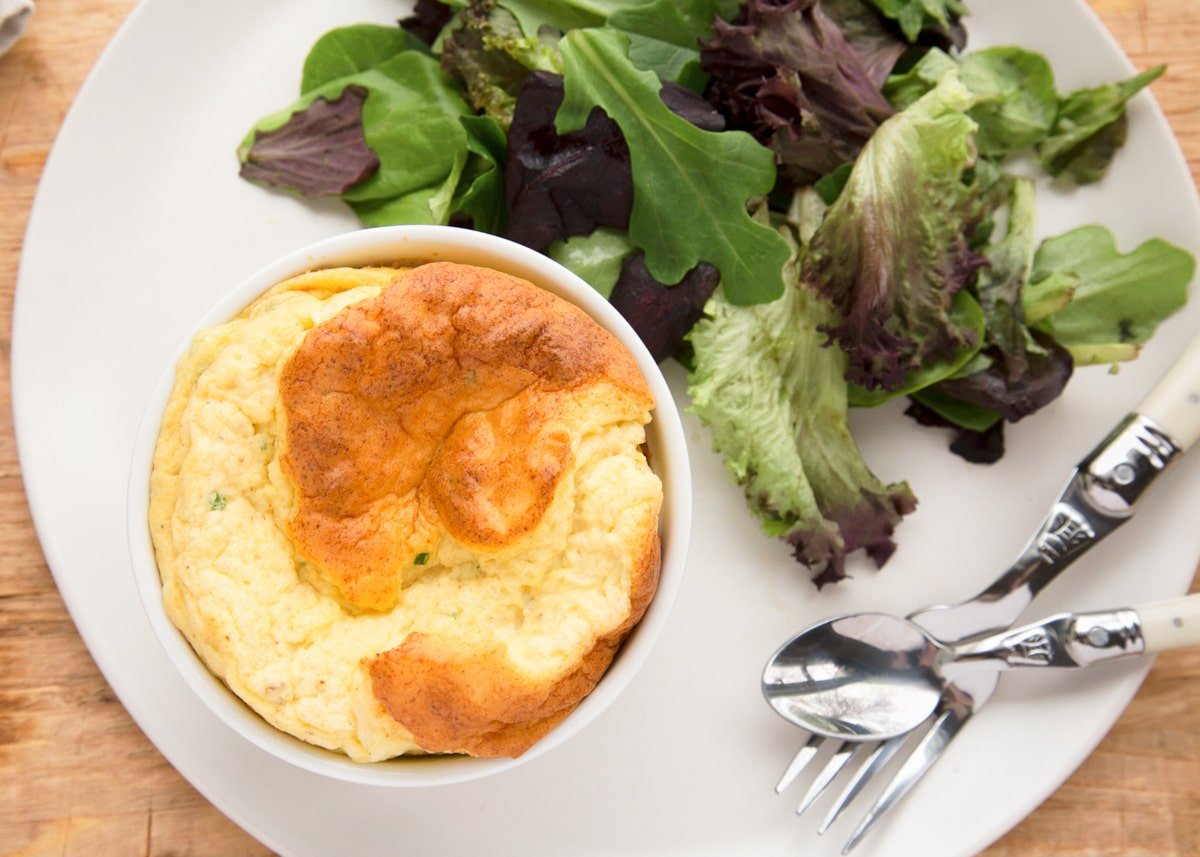
What is a Souffle?
A classic soufflé is a baked French egg dish. It can be savory (like this Cauliflower Soufflé recipe), or sweet (such as a chocolate soufflé served for dessert). Classic soufflés are made with a creamy base, combined with whipped egg whites, and baked until puffed and golden.
The best soufflés have a light, airy, melt-in-your-mouth texture. They make a beautiful appearance right out of the oven, rising tall over the top of the baking dish–a real showpiece if you want to impress guests!
Soufflés can have a reputation for being difficult to make–particularly when it comes to achieving their characteristic “puff”. In my humble experience, the process of making a soufflé is actually pretty straightforward, though it can be finicky.
I find that the key to success lies both in reasonable expectations (i.e., accepting that your soufflé will deflate the longer it sits and that this is normal) and proper handling of the eggs. The most delightful soufflés are all about the egg whites.
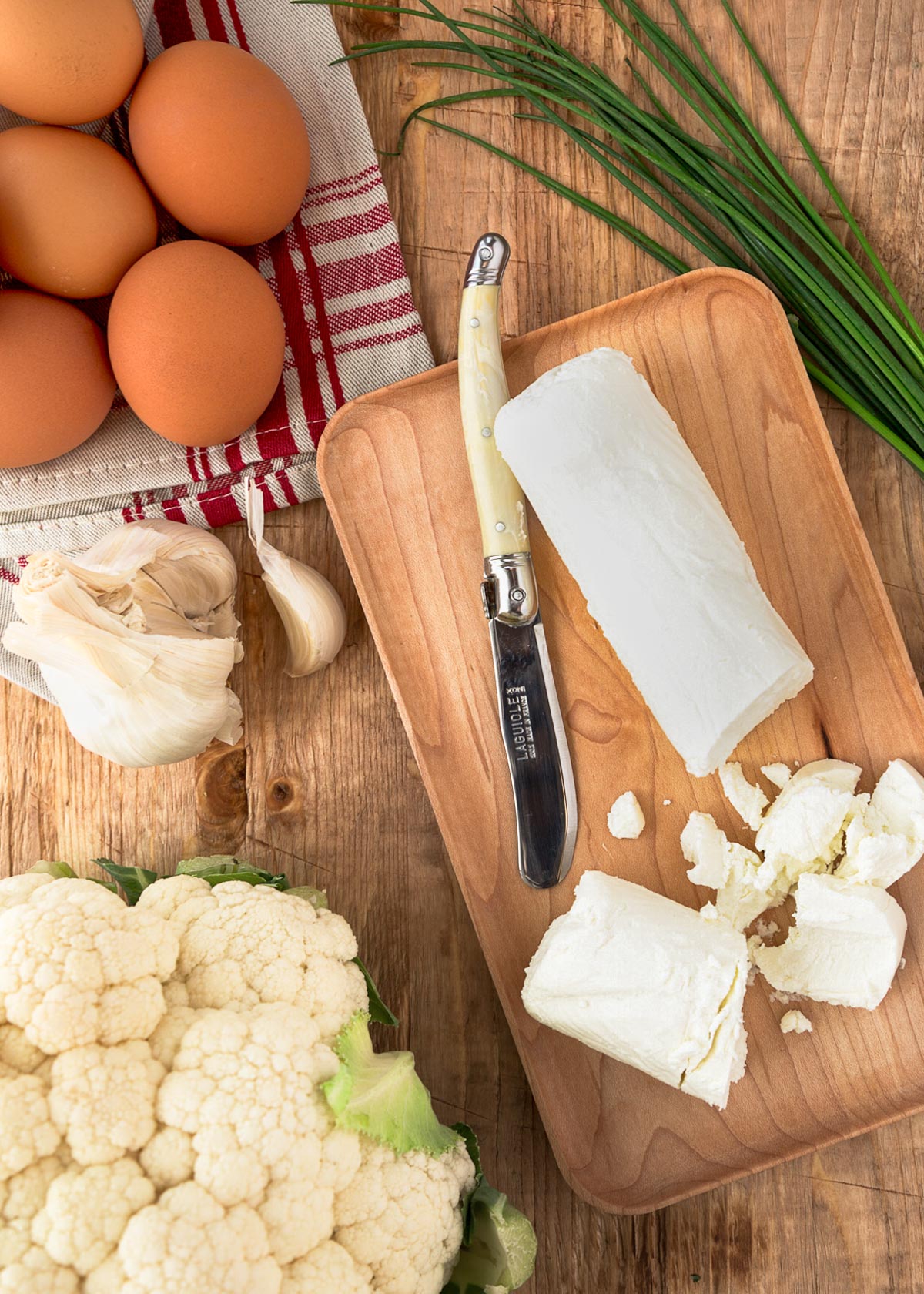
Key Ingredient Notes
- Unsalted Butter. You’ll use melted butter to make the roux for the béchamel (white sauce) base and softened butter to coat the insides of the ramekins.
- Parmigiano Reggiano Cheese. Use grated cheese to dust the buttered ramekins before filling. This will help the soufflé rise up the sides of the dish.
- Cauliflower (Cut into Florets). Roasting transforms the flavor of cauliflower florets, adding a caramelized, nutty flavor to the dish.
- Garlic. Use whole cloves and roast them alongside the cauliflower. They’ll become soft and creamy with a sweet, mellow flavor and aroma, without the harshness that raw garlic can have.
- Olive Oil. For roasting the cauliflower and garlic. I use regular olive oil here, such as Filippo Berio {affiliate link}, not extra-virgin, for its slightly higher smoke point and milder flavor.
- Goat Cheese. Adds a creamy texture and earthy, tangy, buttery flavor to the soufflé mixture. (You’ll need half of a 10-ounce log; my Smoked Salmon Frittata and Bacon and Goat Cheese Popovers are great recipes for using the extras!)
- All Purpose Flour. The thickening agent for your béchamel, setting the stage for a smooth, creamy sauce.
- Whole Milk. Makes the béchamel rich and creamy. For the best flavor, I don’t recommend substituting reduced fat or fat free milk in this recipe.
- Whole Eggs (Separated). The yolks will enrich the soufflé base, while whipped egg whites add air, giving the dish its signature puff and light, airy texture.
- Grated Nutmeg. A classic addition to béchamel that adds a hint of spice and complexity to the soufflé.
- Fresh Chives. Adds a mild, fresh onion flavor that brightens the deeper flavor of the roasted cauliflower.
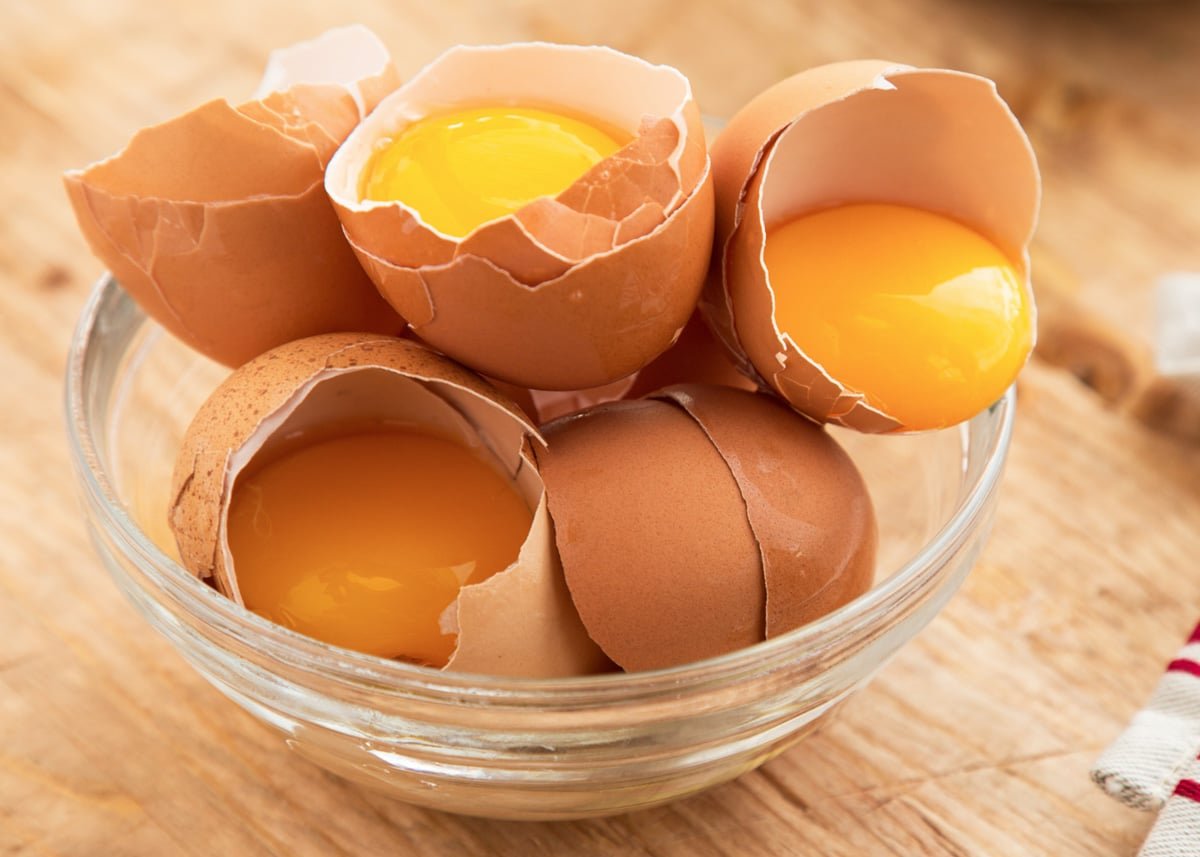
Souffle Making Tools
To make Roasted Cauliflower Souffles, you’ll need six, 10-ounce oven-safe ramekins {affiliate link}. I love the classic look of fluted white porcelain ramekins for soufflés.
You’ll also need parchment paper and cooking twine {affilliate links} to make the sleeves that will allow the soufflés to puff and rise taller than the rim of the ramekins.
For the balance of the recipe, you’ll need a food processor or blender to make the cauliflower and goat cheese puree and a stand mixer (or a hand mixer) to make whipping the egg whites a breeze. (If you prefer, you can whip them by hand with a whisk.)
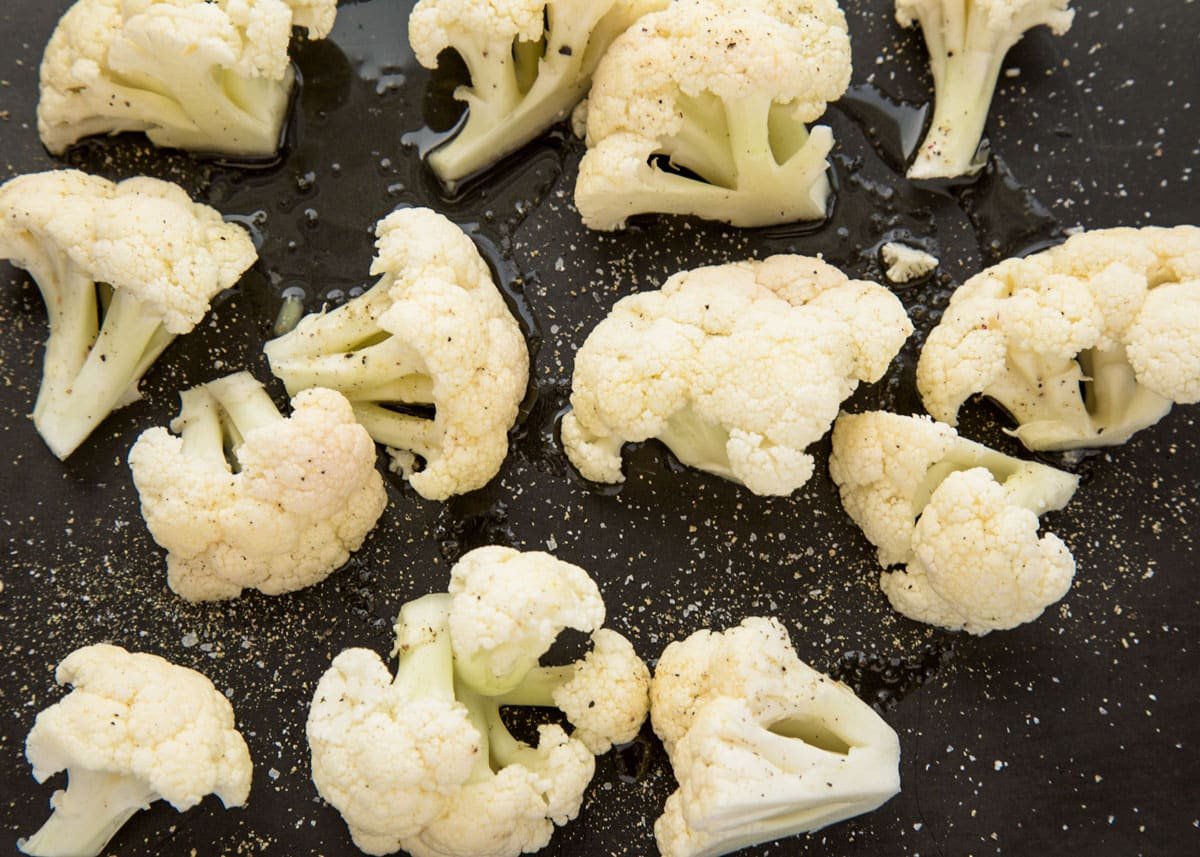
How to Make Roasted Cauliflower Souffles
Before you assemble the soufflés themselves, you have some prep work to do, both in terms of ingredients and equipment. Let’s break it down (more detailed instructions follow in the recipe card at the end of the post):
Step 1: Roast the Cauliflower and Garlic
Get the recipe started by spreading cauliflower florets and garlic cloves on a rimmed sheet pan {affiliate link}. (Line the pan with foil for easy cleanup!)
Toss the cauliflower and garlic with olive oil, salt, and pepper, and roast at 400°F until they’re tender and perfectly caramelized – about 25-30 minutes.
Remember to give them a flip halfway through for an even roast. Once done, let them cool off a bit, then press the garlic out of its skin. Don’t turn off the oven.
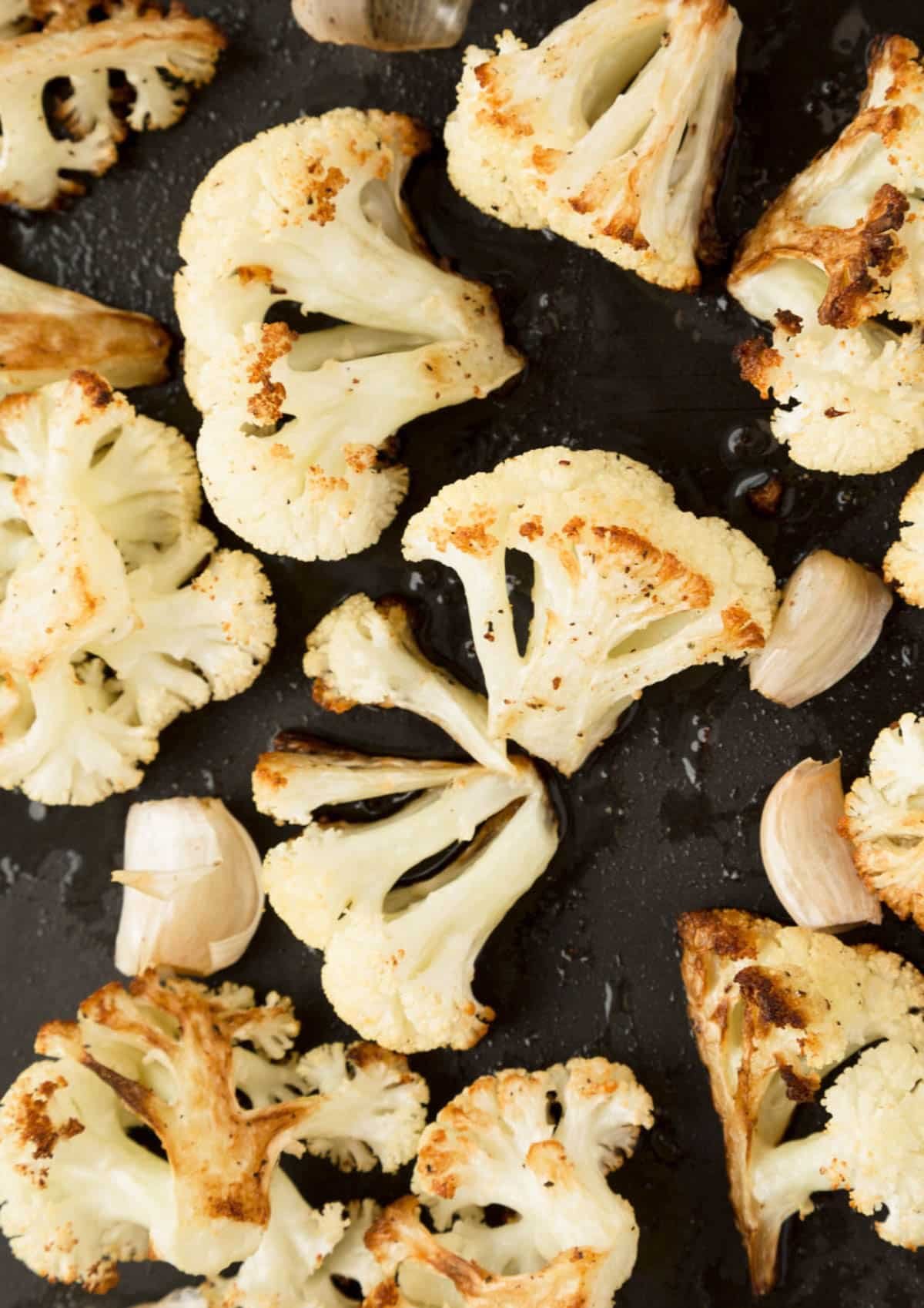
Step 2: Prep the Ramekins
While the cauliflower is roasting, get the ramekins ready. Butter the interiors of the dishes with softened butter and swirl a spoonful of grated parmesan around each to coat, tapping out any excess. Place the ramekins on a rimmed baking sheet and chill them while you make the soufflé batter.
To make the parchment collars, cut the paper into 15×6-inch rectangles. Then, to make them a bit more stable, fold them in half lengthwise (so the collars measure about 15×3-inches). Lightly brush one side with melted butter or spray with cooking spray.
Do not attach the collars to the ramekins until they’re filled with the soufflé mixture. Just have them prepped and ready to go.
Step 3: Make the soufflé base.
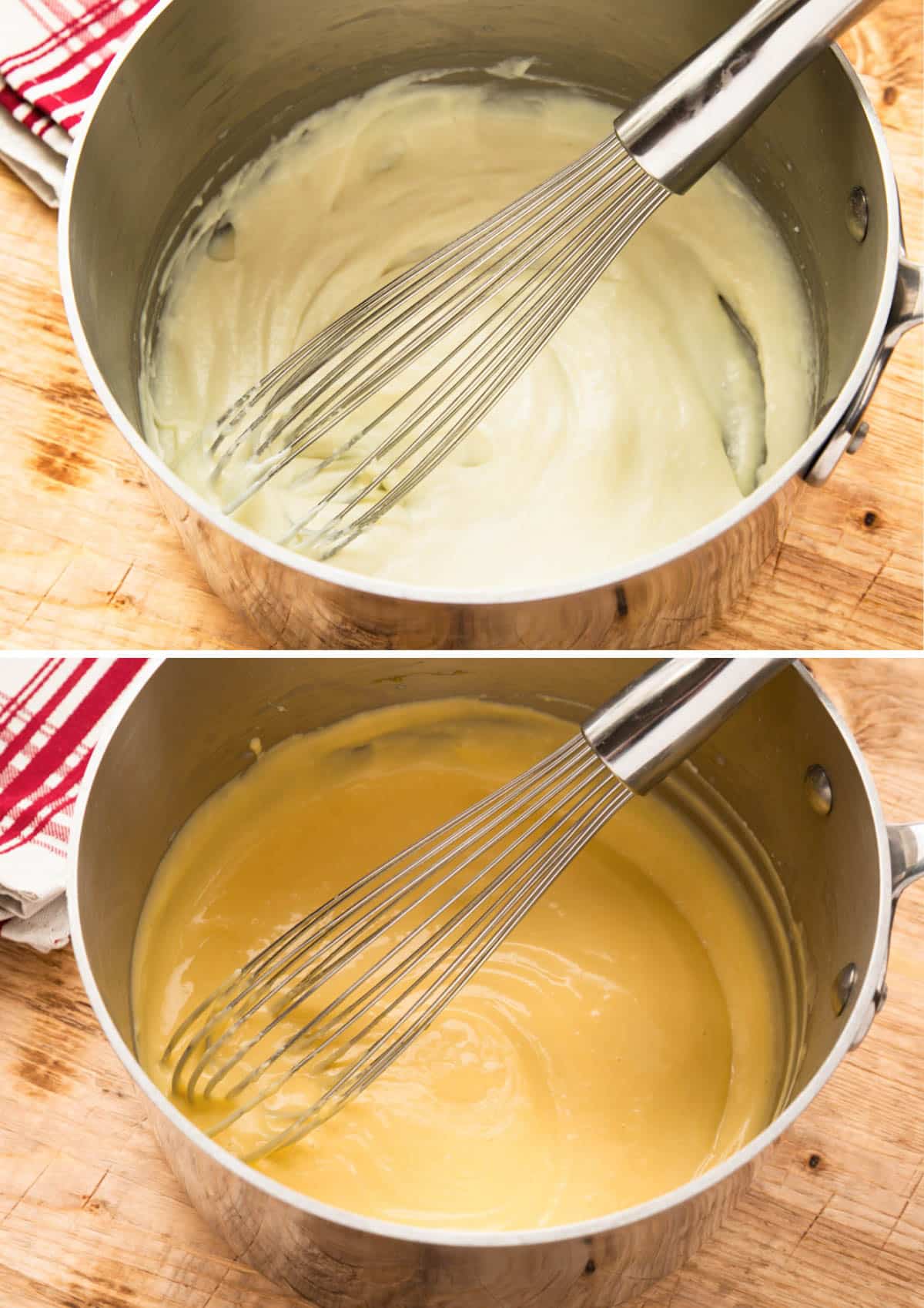
Onto the béchamel sauce–the rich and creamy base for the Roasted Cauliflower Souffles. Melt butter in a saucepan over medium-low heat, whisk in the flour, and cook it just for a couple of minutes to remove the raw flour taste. Then, slowly whisk in the milk and cook for about 5 minutes until the sauce is smooth, thick, and glossy.
Let this mixture cool for a few minutes and then blend in the egg yolks. Set this mixture aside with a piece of plastic wrap pressed onto the surface so a skin doesn’t form.
In a blender or food processor, puree the roasted cauliflower and garlic with goat cheese and seasonings (salt, pepper, nutmeg). Add this puree to the béchamel-egg yolk mixture and stir in chives.
Be sure that the mixture has cooled to room temperature before moving ahead to the next step.
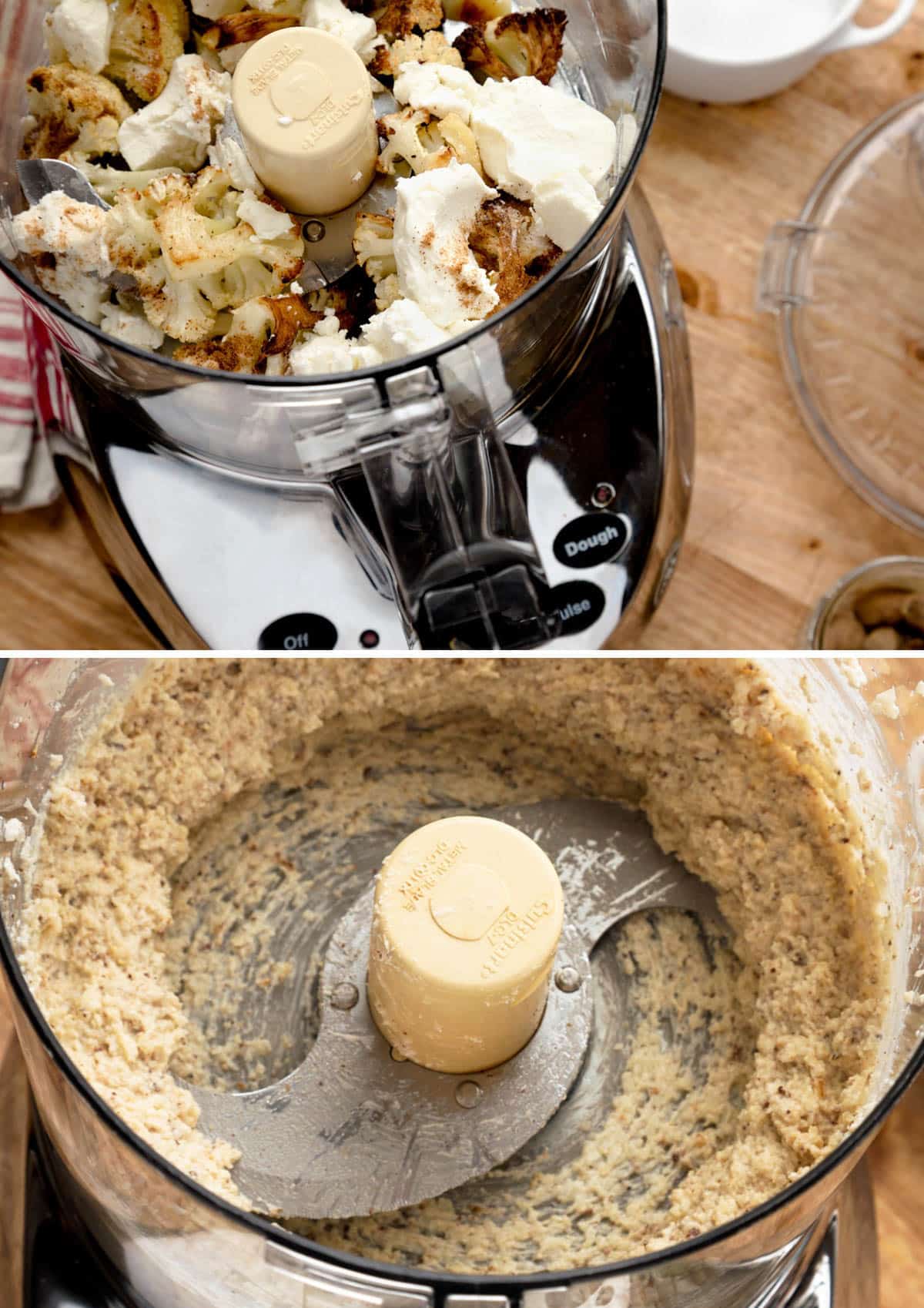
Step 4: Whip the Egg Whites
Whip the egg whites with a bit of cream of tartar until stiff peaks form–this is what will give your soufflés their lift.
Tips for perfectly whipped egg whites:
- Separate your egg whites while they’re chilled for the cleanest results. Once separated, the whites should come to room temperature for the quickest and easiest route to stiff peaks.
- Make sure that both your whipping bowl and beaters are clean and dry. Any oil or fat in the equation (including rogue drips of egg yolks) will make it impossible to whip the egg whites properly.
- Don’t overwhip. Keep a close eye on the egg whites as you’re whipping them. Stop when they’ve attained stiff peaks, but are still moist and billowy in appearance. Over-whipping the whites until they’re very stiff and dry will make them difficult to fold into the base without deflating, and will stunt your soufflé’s rise during baking.
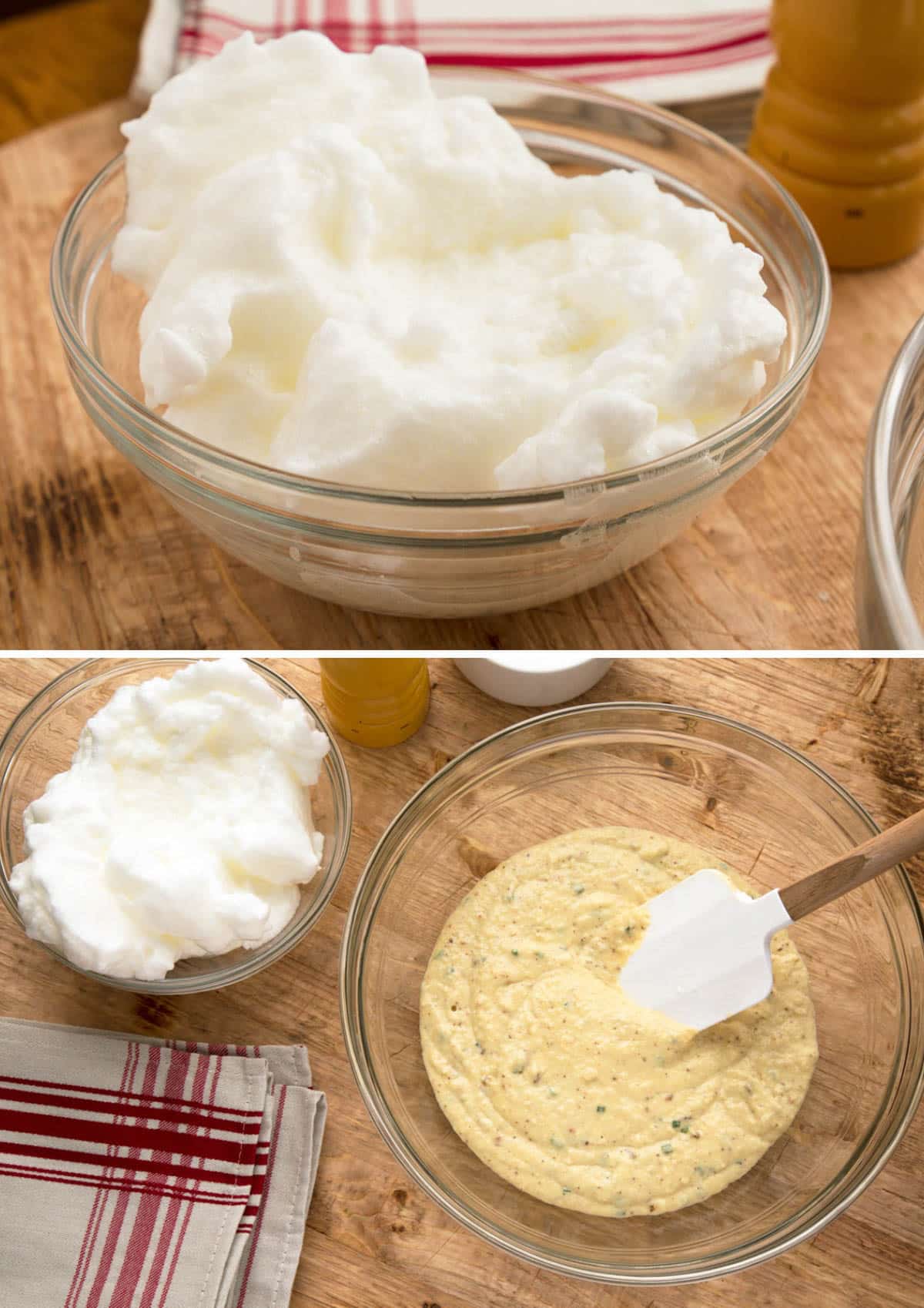
Step 5. Bringing It All Together
The last step before baking is to combine the cauliflower base and the egg whites. Since the base is a bit heavy, I like to start by whisking a proportion of the whites into it to lighten the texture. Then, I gently and slowy fold in the remaining egg whites with a rubber spatula so they don’t deflate.
Don’t rush the step of folding in the egg whites; it’ll take some patience, but you’ll be rewarded with pillowy, beautiful soufflés in the end!
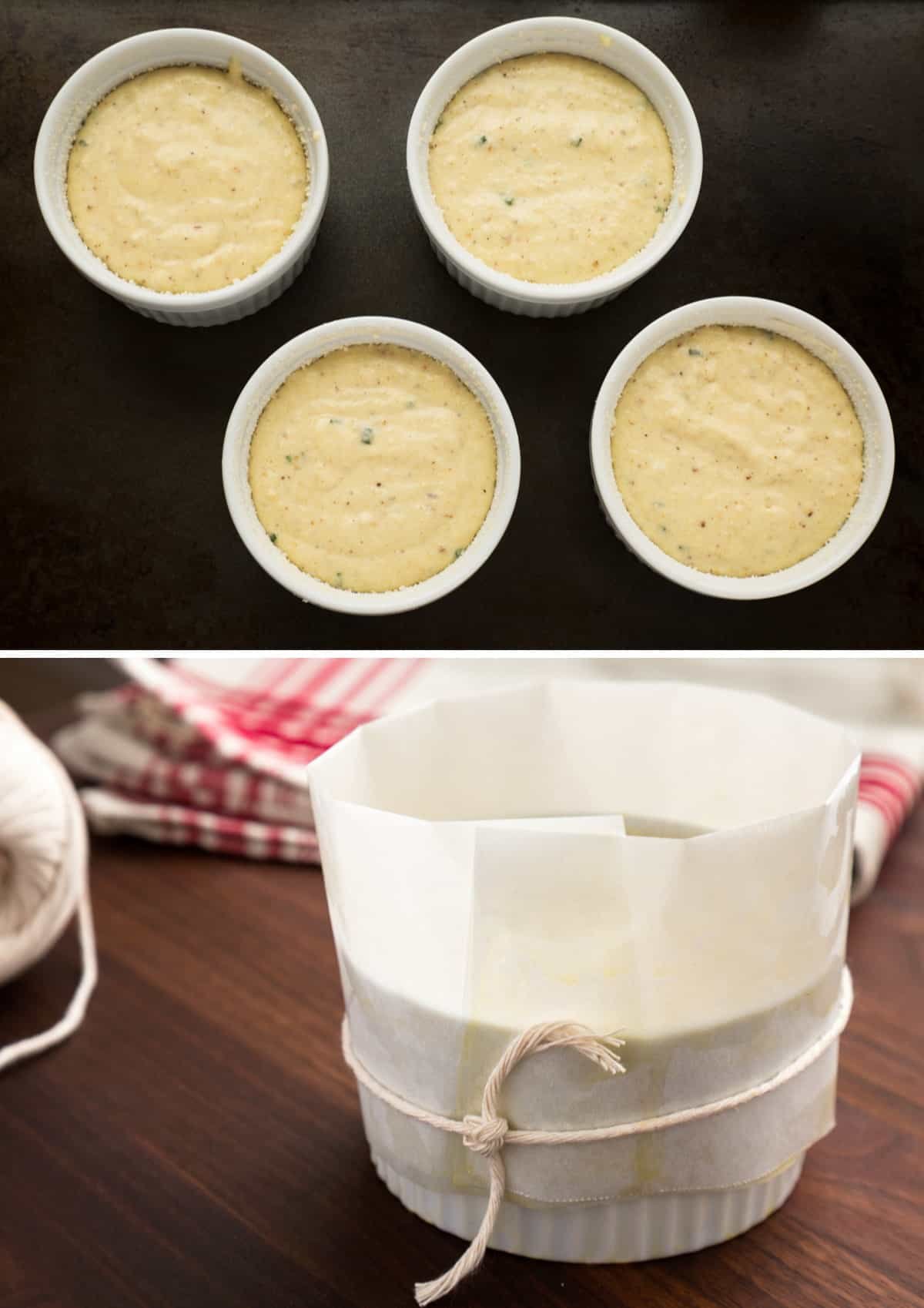
Once the batter is combined, fill your chilled ramekins, affix the parchment collars around the outsides of the dishes with cooking twine, and place them back on the chilled baking sheet.
As soon as you put the ramekins in the oven, reduce the oven temperature to 375 degrees F. Bake for 25-30 minutes, until they rise beautifully and turn golden brown on the top. (You’ll see why you needed those parchment collars!)
Right when the soufflés come out of the oven, gently remove and discard the collars. Sprinkle the tops with chopped chives for a pretty presentation, and serve them immediately.
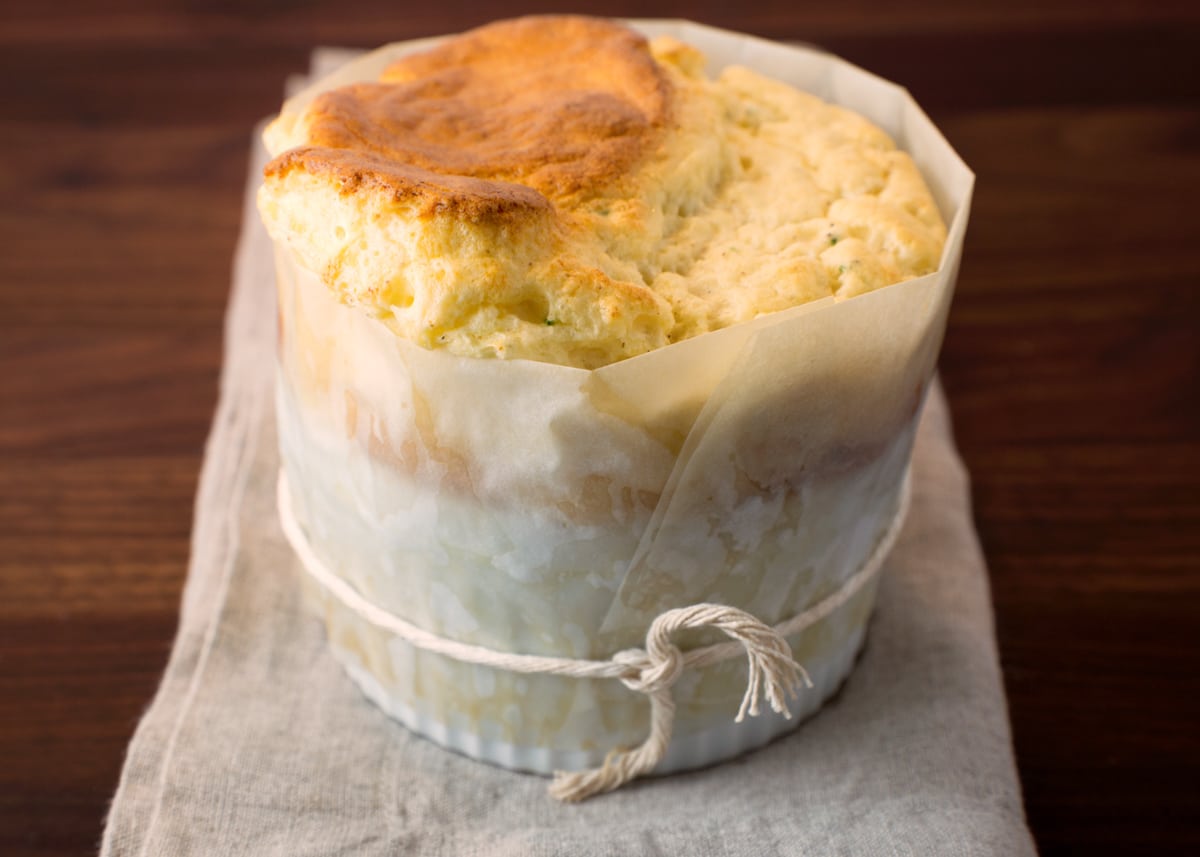
Serving The Souffles
These Roasted Cauliflower Souffles are beautifully served as an appetizer or for a light vegetarian lunch or brunch. They’re also a great option for Meatless Fridays during Lent.
When serving them for a light meal, I like to serve them with crusty bread and lightly dressed spring greens (a mix of mesclun, watercress, baby arugula, etc.). They’re also delicious alongside this simple Arugula and Fennel Salad.
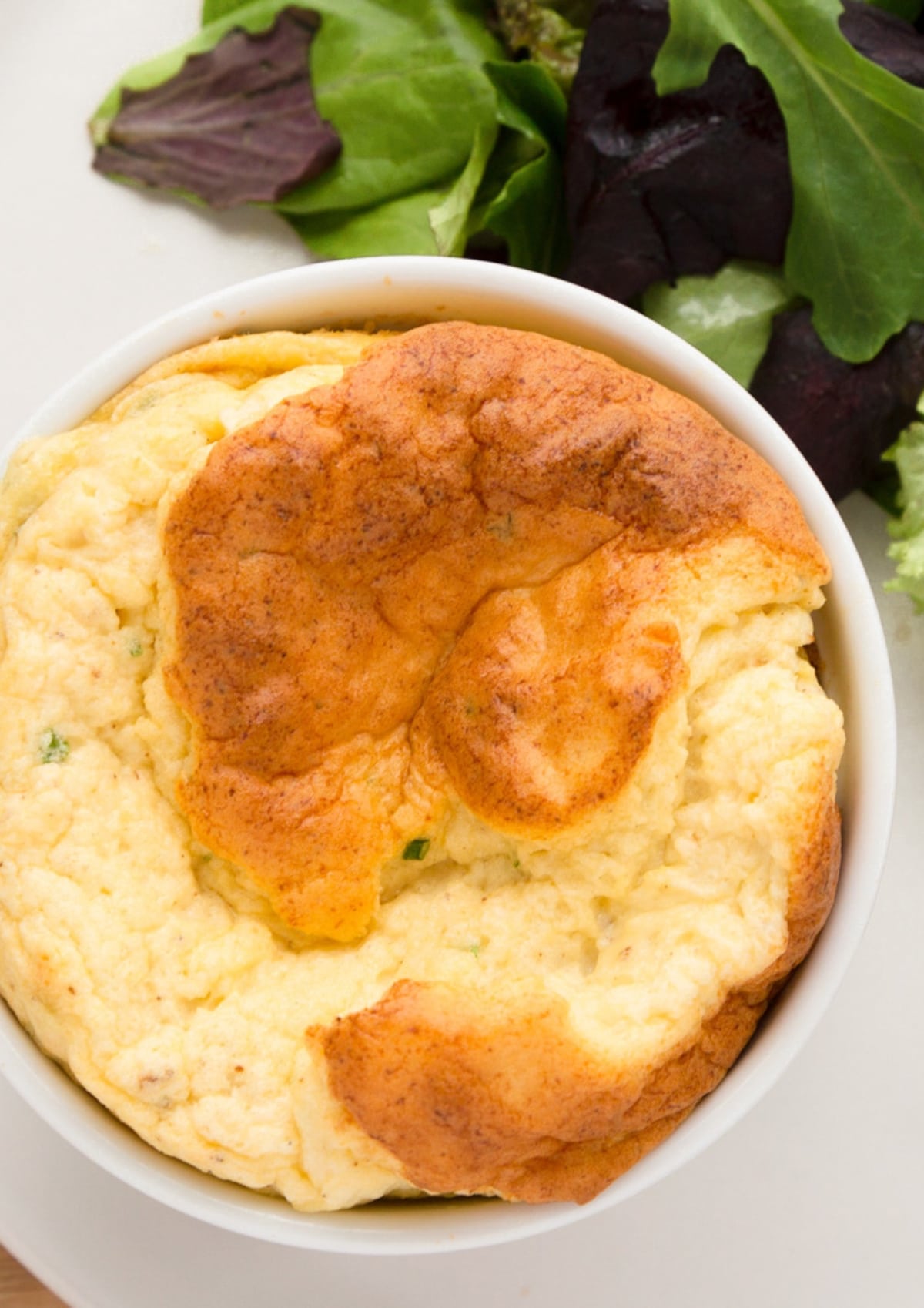
As I mentioned, deflation is inevitable, so the soufflés should be served as soon as possible for the best texture and appearance.
This isn’t the kind of dish that you can pull out of the oven and hold on the back burner for 15 minutes while other dishes finish cooking. If you want to capitalize on the “puff” you worked so diligently to achieve, the soufflé needs to go almost directly from oven to table.
Rest assured that if your soufflé does deflate, it’s still going to taste great. It just won’t have that show-stopping appearance, and the texture will densify a bit. Personally, I’d never say “no” to a fresh soufflé, deflated or not!
More Recipes Using Spring Produce
CRAVING MORE? Subscribe to my newsletter and join me on Facebook, Pinterest, and Instagram for the latest recipes and news.
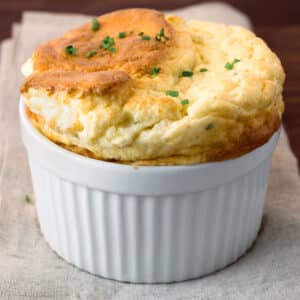
Goat Cheese and Roasted Cauliflower Soufflés
Ingredients
- unsalted butter , softened, for greasing ramekins
- 6 tablespoons Parmigiano Reggiano , grated
- 8 ounces cauliflower florets
- 3 cloves garlic , unpeeled
- 1 tablespoon olive oil
- 5 ounces goat cheese
- 1-1/2 recipes thick Béchamel Sauce (4-1/2 tablespoons flour, 4-1/2 tablespoons butter, 1-1/2 cups milk)
- 5 egg yolks
- 8 egg whites
- 1/4 teaspoon cream of tartar
- 1/4 teaspoon grated nutmeg
- 1 tablespoon snipped fresh chives , plus extra for garnish
- kosher salt
- freshly-ground black pepper
Instructions
Prepare ramekins and soufflé collars:
- Butter six, 10-ounce ramekins and coat each with about 1 tablespoon parmesan cheese, tapping out excess. Place ramekins on a baking sheet and chill until ready to use. Cut parchment collars for the ramekins to extend past the top of each ramekin 1-1/2 to 2 inches.* Set aside (don’t secure onto ramekins until ready to bake).
Roast the cauliflower and garlic:
- Preheat oven to 400 degrees F with rack in middle position. Cut a small slice off of each end of the garlic cloves, exposing the interior without removing the peels. Toss cauliflower florets, garlic, and olive oil on a baking sheet. Sprinkle with a few pinches of kosher salt and freshly-ground pepper. Roast 25-30 minutes, turning cauliflower florets halfway through for even browning, until tender and caramelized. Remove from oven and set aside to cool. Squeeze garlic cloves from peels and discard the skins.
Make the soufflé base:
- Make the Béchamel Sauce and let cool 2-3 minutes. Whisk in egg yolks, one at a time, until fully combined and smooth. Place a piece of plastic wrap onto the surface to prevent a skin from forming and set aside.
- In a food processor, process roasted cauliflower, garlic, goat cheese, ground nutmeg, 3/4 teaspoon kosher salt, and a few grinds of black pepper until you have a smooth puree. Scrape the bowl as needed to ensure that all of the cauliflower is incorporated. Whisk cauliflower puree and 1 tablespoon chopped chives into the Béchamel-egg yolk sauce until combined. If the mixture is still warm, let it stand until it reaches room temperature.
Assemble the soufflés:
- In a stand mixer fitted with the whisk attachment, or a clean bowl with a hand mixer, whip egg whites until foamy. Add cream of tartar and continue whipping until whites are voluminous and stiff, but not dry.
- Whisk about 1 cup of the egg whites into the cauliflower mixture to lighten. Using a rubber spatula, gently fold in the remaining egg whites in 2-3 additions, until no streaks remain. Divide the soufflé mixture between the six prepared ramekins. Grease pre-cut parchment collars and secure onto the exterior of the ramekins with kitchen twine or pins.
- Place the ramekins (on the chilled cookie sheet) into the oven and immediately reduce the temperature to 375 degrees F. Bake 25-30 minutes, until soufflés are puffed, light golden brown, and a tester inserted into the center comes out clean or just slightly moist. Remove from oven and gently but swiftly remove collars (soufflés might deflate a little during removal). Sprinkle with chopped chives, if desired, and serve immediately.
Notes
Nutrition Estimate
Nutrition information is automatically calculated, so should only be used as an approximation.
About our recipes
Please note that our recipes have been developed using the US Customary measurement system and have not been tested for high altitude/elevation cooking and baking.

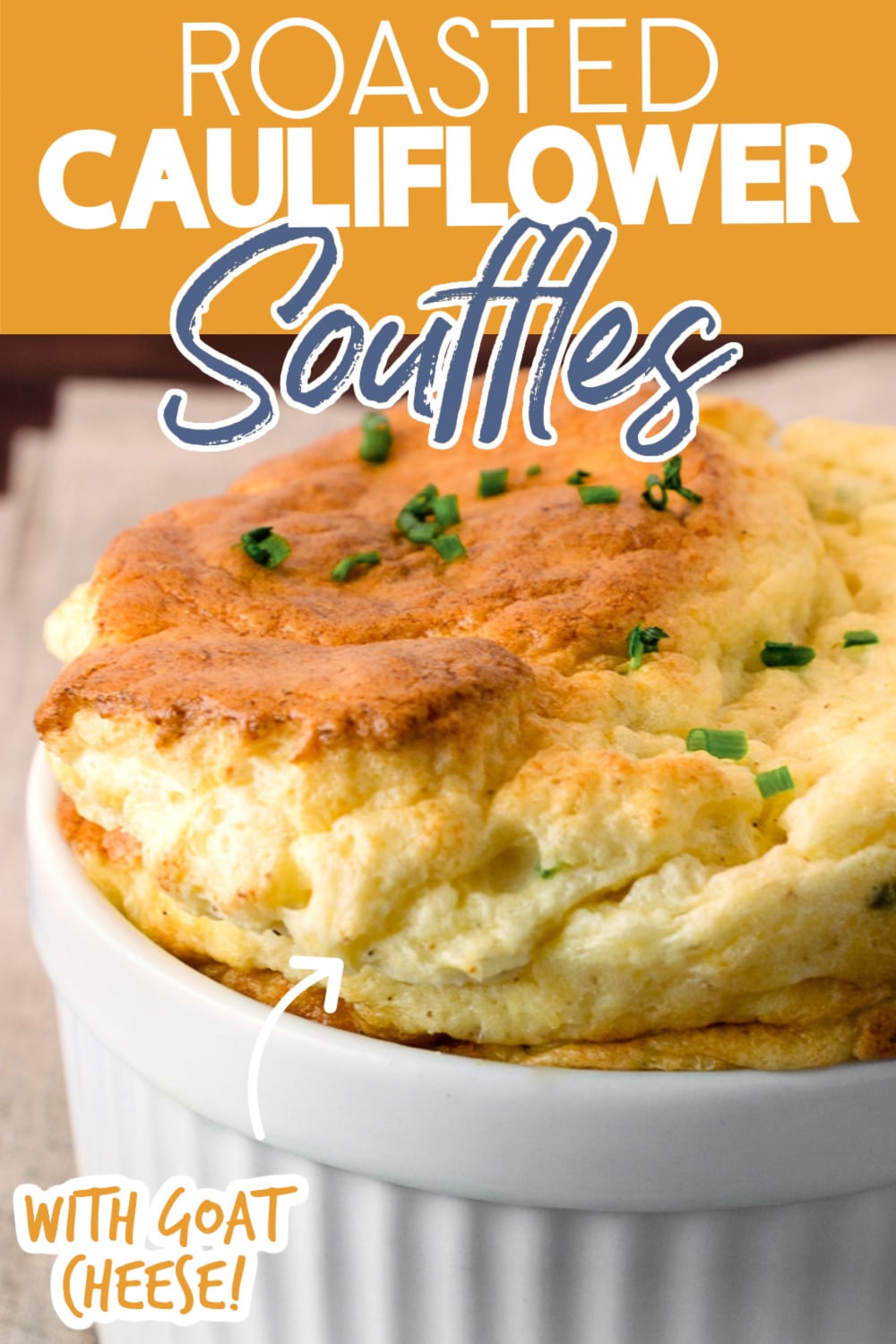

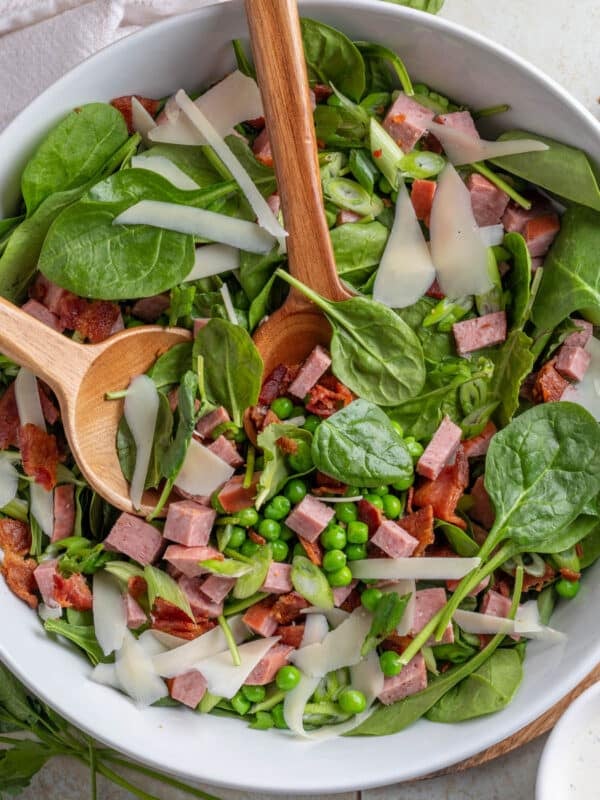
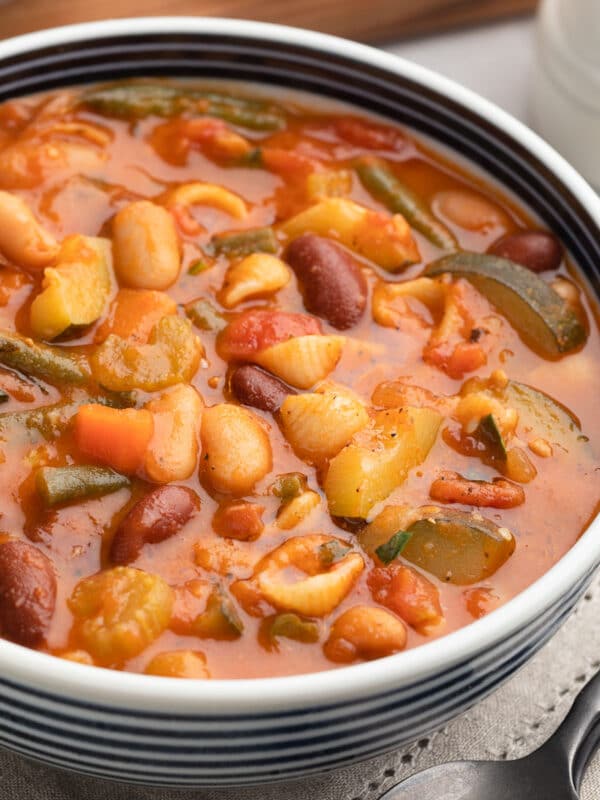











I love your recipe I made it few times everyone favorite
So, first – I’d like to be one of your official testers and second these souffles are absolutely luscious looking. Sign me up!
Wow, your soufflé is absolutely beautiful! Love that you added goat cheese.
Looks really good. I am going to try making it this week.
Can this be made in a bigger pan rather than making individual servings?
Hi Sush. Yes, the soufflé can be baked in a large, 2-quart soufflé dish (similarly fitted with a collar). The baking time will likely need to be increased by 5 minutes or so, but keep an eye on it. Enjoy!
I am so impressed. What a cute Souffle!! This is a pretty little lunch idea or light dinner. I must give this one a try for sure!
These look divine! I can’t wait to try them. So beautifully photographed too!
Thanks, Caroline! I had fun photographing these. I usually take my time photographing a finished recipe, but hot soufflés wait for no one! :) It was a fun process. Thanks for reading and commenting!
Thanks so much for your very nice comment, Kim! I hope you enjoy these soufflés as much as we did if you try them!
I was just wondering if you could use soy flour and get Goethe same consistency?
Hi Autumn, thanks for reading and for your question. I’ve never tried making a Béchamel with soy flour, so I can’t speak from experience on the substitution. I’m not sure that it would thicken the same as all-purpose flour (soy being one of the lower-starch gluten-free flours). I do know soy flour has a stronger taste, which might not meld as well with the other flavors in these soufflés.
I had souffle once on a cruise and have been obsessed with it ever since! Added veggies makes me feel better about making it at home, definitely trying this
Hi Carmella – I love soufflés, but the combination of a soufflé and a cruise sounds even better! :) Thanks for commenting!